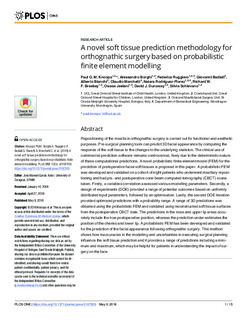Izenburua
A novel soft tissue prediction methodology for orthognathic surgery based on probabilistic finite element modellingEgilea
Egilea (beste erakunde batekoa)
Argitalpen data
2018Bertsioa
Bertsio argitaratuaDokumentu-mota
ArtikuluaArtikuluaHizkuntza
IngelesaEskubideak
© 2018 Knoops et al.Sarbidea
Sarbide irekiaArgitaratzailearen bertsioa
https://doi.org/10.1371/journal.pone.0197209Non argitaratua
PLoS ONE Vol. 13. Nº. 5. May 2018Argitaratzailea
PLOSGako-hitzak
maxillofacial surgery
simulation
deformations
distraction ... [+]
simulation
deformations
distraction ... [+]
maxillofacial surgery
simulation
deformations
distraction
validation
deformity
cartilage
accuracy
system
skin [-]
simulation
deformations
distraction
validation
deformity
cartilage
accuracy
system
skin [-]
Laburpena
Repositioning of the maxilla in orthognathic surgery is carried out for functional and aesthetic
purposes. Pre-surgical planning tools can predict 3D facial appearance by computing the
response of t ... [+]
Repositioning of the maxilla in orthognathic surgery is carried out for functional and aesthetic
purposes. Pre-surgical planning tools can predict 3D facial appearance by computing the
response of the soft tissue to the changes to the underlying skeleton. The clinical use of
commercial prediction software remains controversial, likely due to the deterministic nature
of these computational predictions. A novel probabilistic finite element model (FEM) for the
prediction of postoperative facial soft tissues is proposed in this paper. A probabilistic FEM
was developed and validated on a cohort of eight patients who underwent maxillary repositioning
and had pre- and postoperative cone beam computed tomography (CBCT) scans
taken. Firstly, a variables correlation assessed various modelling parameters. Secondly, a
design of experiments (DOE) provided a range of potential outcomes based on uniformly
distributed input parameters, followed by an optimisation. Lastly, the second DOE iteration
provided optimised predictions with a probability range. A range of 3D predictions was
obtained using the probabilistic FEM and validated using reconstructed soft tissue surfaces
from the postoperative CBCT data. The predictions in the nose and upper lip areas accurately
include the true postoperative position, whereas the prediction under-estimates the
position of the cheeks and lower lip. A probabilistic FEM has been developed and validated
for the prediction of the facial appearance following orthognathic surgery. This method
shows how inaccuracies in the modelling and uncertainties in executing surgical planning
influence the soft tissue prediction and it provides a range of predictions including a minimum
and maximum, which may be helpful for patients in understanding the impact of surgery
on the face. [-]
Sponsorship
This work was supported by the Great Ormond Street Hospital Charity http://www.gosh.org/: grant FaceValue (no. 508857) to Silvia Schievano, David Dunaway, Owase Jeelani; Engineering and Physical Sciences Research Council https://www.epsrc.ac.uk/: award no EP/N02124X/1 to Silvia Schievano and this work was undertaken at Great Ormond Street Hospital and University College London Institute of Child Health, who received a proportion of funding from the United Kingdom Department of Health’s National Institute for Health Research Biomedical Research Centre funding scheme. The funders had no role in study design, data collection and analysis, decision to publish, or preparation of the manuscript.Projectu ID
United Kingdom. Great Ormond Street Hospital Charity. 50885. FaceValueBildumak
Item honek honako baimen-fitxategi hauek dauzka asoziatuta:






















